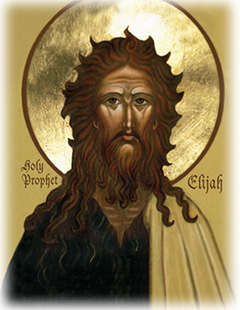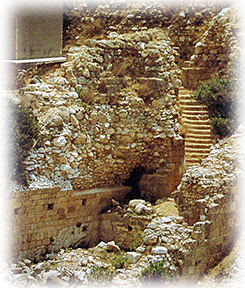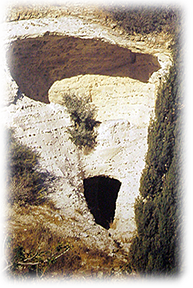
Origin of
the Order

Carmel is a Heritage...
Carmelites today, in going back to their primary sources of inspiration, have a very rich heritage in the prophet Elijah. The Fathers of the Church have always marked Elijah as the great solitary, the contemplative. Commentaries on the Book of Kings show us the influence Elijah had on all hermits and contemplatives.
The Hebrew Scriptures contain wonderful stories about the great prophet Elijah. He stood in the living presence of God as Yahweh’s sole remaining prophet in the time of King Ahab, whose pagan wife Jezebel had established the worship of the fertility god Baal in Israel.
Elijah prayed ardently and confronted the nation with a three-year drought that confirmed the futility of devotion to Baal. He then summoned the king and the people and the four hundred and fifty prophets of Baal to the top of Mount Carmel for a dramatic confrontation. Who was the true God in Israel?
Let the prophets of Baal prepare the sacrifice of a young bull and call upon their god, but start no fire to consume the holocaust, while Elijah would do the same and call upon Yahweh. Whoever answered with fire was God! It was Yahweh who won the victory, and who then, at the earnest prayer of his prophet, sent the blessing of rain in torrents upon the parched earth.
Since then, the mountain of Carmel, a lovely and verdant cliff into the Mediterranean Sea, has been regarded as a symbol of prophetic, zealous, solitary encounter with God.

To this day the memories of Elijah and the mountain of Carmel are kept, not only by the faith tradition of Israel, but by Islam and Christianity as well.
In the 13th century, Christian Crusaders who had experienced a deep religious conversion were drawn by the attraction of Mount Carmel. They gradually established a site of solitary cells around the traditional "Spring of Elijah," where they built an oratory in honor of their Lady, the Virgin Mary, and began to follow an interior call to deep solitude and prayer.
Eventually they asked the Patriarch of Jerusalem, St. Albert, to write for them a Rule that would express the charism that inspired them. Succinct and filled with quotations from Scripture, the Rule bound the little band of hermits in a semi-cenobitic existence, although the emphasis remained of "the deep interior call" to prayer and union with God in the crucible of poverty and solitude. They called themselves the Brothers of Our Lady of Mount Carmel.


Vaulted chamber & stairway in a monastery Cave on Mt. Carmel
By 1239, the hermit monks were obliged by persecution to migrate to Europe. There they found they had to adapt their lifestyle to the "mendicant" model established by the Franciscan and the Dominican friars. The contemplative roots remained strong, as did their devotion to Our Lady, for which they were famous. By the 15th century, communities of women had been established in the Order, whose cloistered lifestyle was well suited to a life of deep prayer.

As a bolt of lightening, St. Teresa of Jesus (Avila) burst into the life of Carmel, in Spain of the XVlth century, bringing her gifts of nature and grace to the very large and somewhat disordered community of Carmelites, when many entered the cloister for reasons other than the call to prayer.
After a first conversion and a long apprenticeship of prayer, she conceived the idea of refounding small sisterly communities of cloistered women in the primitive spirit of Carmel. She was inspired by the prophets and fathers of Mount Carmel and by her own deep submission to the guidance of the Holy Spirit. She set up a way of life that demanded poverty and solitude, but in a setting of sisterly friendship fired by an ardent apostolic zeal to be, first of all, faithful friends of the Good Jesus.
This way of life, which began as a small reform, eventually grew into the Order that came to be known as the Discalced (shoeless – a term that designated poverty and reformation) or Teresian Carmelites.
St. Teresa was the first woman to be declared a doctor of the Church, and has left us a rich heritage of warm and personal writing aimed at guiding the soul, or "the interior castle," to its inmost chamber of union with God. Her contemporary and close collaborator, St. John of the Cross, has also been declared a doctor of the Church. Acclaimed as one of Spain’s most eminent poets, he wrote ardent mystical poetry as well as wise and penetrating explanations of the advanced stages of the spiritual life. Both of these saints are being discovered anew today, and their doctrine is as fresh and vital to the seekers of the 21st century as it was to those of medieval Spain.